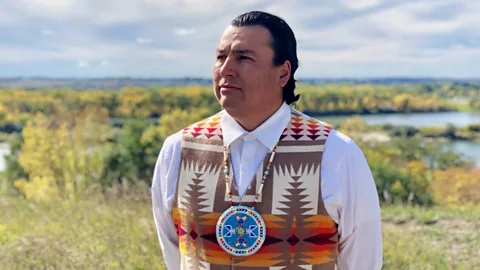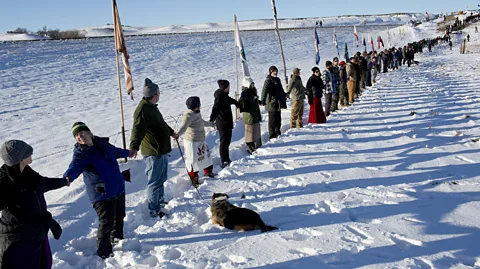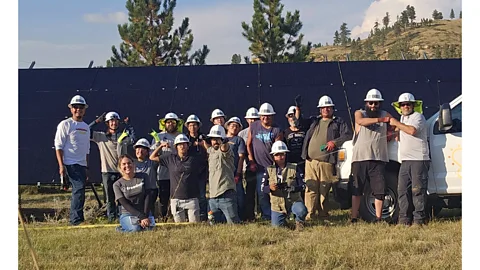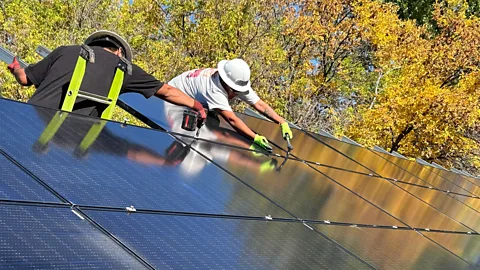Native Americans are building their own solar farms
 Indigenized Energy
Indigenized EnergyFor decades, Native Americans were reliant on the US government to bring them power. Now, that may be changing.
It was at Standing Rock, as he watched a fellow protester be cuffed and manhandled into a police car, that Cody Two Bears, member of the Sioux tribe in North Dakota, decided he would build a solar farm.
"I realised I didn't want to just talk about it, protest about it," he says, reflecting on the months-long protests that took place in 2016, to prevent the Dakota Access Pipeline from being built on sacred tribal land. "I wanted to be about it."
At the time, Two Bears was on the tribal council of the Cannon Ball community of Standing Rock. He was a key member in organising the pipeline protests, which had hoped to prevent a 1,172 mile (1,886km) long underground pipe to transport crude oil from North Dakota to Illinois. The pipeline was eventually built despite multiple appeals to have the line shut down. However, a lawsuit brought by the Standing Rock Sioux Tribe was successful, requiring a complete environmental review of the pipeline.
"I learned about the impacts of fossil fuels on communities like ours, who don't really have a voice," says Two Bears. "And it seems these large infrastructural projects always happen in places of low-status communities. And one came to my back yard."
 Getty Images
Getty ImagesWhen Two Bears left politics in 2017, he formed Indigenized Energy – a native-led energy company installing solar farms for tribal nations – free of charge. Not only have tribes struggled to tap into the billions in renewable energy incentives offered by the government, they've struggled to have access to any electricity at all.
Much-needed electrification
Reservations are some of the poorest communities in the country – one in three Native Americans live in poverty – and many tribes lack access to basic power. On the Navajo Nation, the largest reservation in the States, 30% of homes don't have electricity, despite the land having been mined for coal and uranium for decades, with little of the profit going to the Navajos. The average cost of connecting a home on the Navajo reservation to the electric grid is $40,000 (£33,000).
Bringing renewables to tribal land is no mean feat, especially in states like North Dakota, the country's third-biggest oil-producing state. "Some of the tribes in the Midwest are really struggling, and I told myself, if we could launch a solar farm there, we could do it anywhere," Two Bears says.
Skilling up indigenous tribal members was key to bringing solar power to the Cannon Ball reservation, as even once the 300-kilowatt solar farm – enough to power 60 homes – was installed, it would need to be managed and maintained.
For projects with low-cost financing, solar energy has become the cheapest form of energy in the world. It's an attractive option for tribes who historically have had little access to reliable energy. Thanks to the Inflation Reduction Act of 2022, the tribe can get tax subsidies of up to 30% for solar and wind farms, as well as grant programmes for electrification, climate resiliency and energy generation. This amounts to around $14bn (£11.5bn) in subsidies and incentives.
The funds, however, can only be accessed once tribes secure an agreement to connect to the regional electrical grid – an expensive and complex process that can take years. Other incentives expire as early as 2024, meaning a "once in a lifetime opportunity" could go to waste, says Chéri A. Smith (Mi'kmaq Descendant), president of the Alliance for Tribal Clean Energy Founder. "All of that money isn't going to do its job unless we remove these roadblocks."
The Sage Development Authority, a corporation created by the Standing Rock Sioux Tribe as a public power authority, has so far spent $3m (£2.4m) on technical studies and fees for their wind farm project to remain in the queue to connect to the electric grid, with no guarantee their application will be approved.
 Indigenized Energy
Indigenized EnergyRenewable energy technologies provide opportunities for tribes to diversify, become energy independent, and create new revenue streams. "Now there's no cheaper form of doing energy anywhere in the country than on native land," says Two Bears. "So that's the key opportunity now for tribes to really get involved in what energy can do for these communities." Cannon Ball's 1,100-panel solar farm saves the tribe up to $10,000 (£8,250) annually in energy costs.
Upskilling tribes
Training Native Americans for renewable energy jobs is an approach Henry Red Cloud, of the Oglala Lakota Nation, wanted to take when he founded Red Cloud Renewable in 2002. The non-profit, which is now run by his son John Red Cloud, works with more than 70 tribes to upskill members so they can find jobs in the renewable energy sector. So far, the organisation has provided free training to more than 1,100 indigenous people as solar installers.
Henry – who Two Bears dubs the "OG of renewable energy" – was born and raised on Pine Ridge, a reservation in South Dakota, but had to leave to find work. "I always had the calling to go back home," he says, "but I'd return home and find it was in dire straits. There was no work. It was pretty bleak." Henry began looking into solar, and realised there were no Indigenous tribal members in the field – and so Red Cloud Renewables was born.
The education is free for tribal members, who are provided with housing, food and mock roofs to practice on. By the end of the course the students install solar panels, for no charge, in community homes. Graduates, who range from their late teens to late 50s, receive a pre-apprenticeship certification. Next year the organisation is launching a new programme for graduates providing career services, such as help with resumés and interview coaching. The graduates often go on to work for solar companies – usually in other states as the renewable energy industry is sparse in South Dakota. Another initiative for native women, which will provide childcare whilst mothers train, is also in the works.
"Indigenous people have been embracing the Sun for eons," says John. "It's in our culture, our ceremony, our song, our dance. So we're taking this new way to honour the old way and then become sustainable in every aspect. And that only happens from the grassroots."
Ahead of the game
There are advantages to this ground-up approach to transitioning to renewables. Wind and solar generation have been the subject of local conflict and opposition in many communities in the US. Meanwhile, attachment to fossil fuels remains significant – 32% of Americans still believe the country should expand the exploration and production of oil and coal. Onshore wind and solar farms require at least 10 times as much land per unit of power produced than coal or natural gas-fired power plants, meaning they can be unpopular in areas unused to industrial development. Additionally, bureaucracy and a wildly inconsistent approach to adopting renewable energy between states has led to slow and diluted action.
Henry Red Cloud's vision is to see one of the country's 574 federally-recognised tribes become energy-independent before the rest of America – "to show the whole country that it can be done". "The country needs that," he adds. "People need to see that. It's time to heal the past and move forward."
Tribes have found that being sovereign nations – with the authority to self-govern – has meant they have been able to roll out renewables a lot faster than municipalities. "There's none of the red tape and legal and policies that makes these things difficult to do," says Two Bears.
 Indigenized Energy
Indigenized EnergyThe tribes are looking to the long term, and how to transition to renewables in the right way.
"What separates us from the rest is we really take the time to do that capacity building within the communities," says Two Bears. "We have too many organisations out there who parachute into these projects and leave. They never really take the time to educate people on the ground and how to maintain and sustain what's been created there."
His dream is to create enough energy not just for the tribe, but to sell back to the national grid and provide for the rest of the country.
Energy sovereignty
Renewable energy isn't just bringing jobs, economic opportunities and power to reservations. There's something less tangible filtering in – wrapped up in the historical treatment of Native Americans by the US government, and the stripping away of rights and cultural values that happened when America was colonised.
The reservations that the government assigned to Native Americans were purposefully on unproductive and hard-to-farm land. But now, the tables have turned and it is native land that has some of the best conditions for wind and solar. "Some of the lands that were the worst lands 160 years ago are now some of the most pristine because our tribal nations have protected and preserved them," says Two Bears.
Having access to – and control over – their own power sources has birthed the term "energy sovereignty". "We want to have the primary role in the direction of our life," says John. "That sovereignty really embodies the spirit of a lot of Native people, it's our guidance in many ways."
In some communities, having access to reliable energy resources becomes a life-or-death situation. When there are pressures on the power grid, communities of colour and low-status groups are commonly the first to suffer. When Texas experienced a freak winter storm in 2021, the blackouts disproportionately impacted black neighbourhoods. "Power outages can be deadly, and medically vulnerable, socioeconomically vulnerable, and marginalised groups may be disproportionately impacted or less prepared… Climate and energy policy must equitably address power outages", a subsequent paper on the power crisis stressed.
"So becoming an energy sovereign is really important," Two Bears continues. "It protects in a way we can live a healthy life and generate economic development. Energy sovereignty creates jobs, it provides hope, it provides a way of life that the outside world has but that indigenous communities don't."
You might also like:
The energy transition undoubtedly provides an opportunity for indigenous communities – as one report noted, renewable energy production "presents a potential pathway to reconciliation, climate change mitigation and a just energy transition".
Carbon Count
The travel emissions it took to report this story were 0kg CO2. The digital emissions from this story are an estimated 1.2g to 3.6g CO2 per page view. Find out more about how we calculated this figure here.
However it's an opportunity that must be led by native people in order for it to be equitable. Around the world indigenous people object to renewable energy projects that threaten their land tenure, management, rights, and way of life. In the US, numerous projects have been met with vehement opposition from tribes; lithium mining in Nevada, hydroelectricity in Washington state, and offshore wind on the Central Coast of California – to name a few. The projects do not consider the impact on the environment, the tribes argue, and producing energy is being prioritised over protecting biodiversity.
"The most important thing is that we have to do it in the right way," Two Bears adds. "We have to protect tribes so that the wild west of colonisation doesn't just come into our tribal communities, use our land to create renewable energy, provide resources to the rest of the world, and then we don't benefit."
Indeed, if the US's current policy framework doesn't change, policymakers "risk continuing the long history of exploitative resource development on reservations", a policy review paper published in 2019 warned. The report added that current legal structures continue to limit tribal self-determination, and impede utility-scale renewable energy develop on reservations.
But Two bears remains hopeful. "We can lead the way in this energy transition. This is a chance to rewrite history."
--
Correction: This article was updated on 14 December 2023 to clarify that a renewable power project that the Standing Rock Sioux tribe is working to connect to the grid is via its SAGE Development Authority, and is a wind farm project.
--
If you liked this story, sign up for The Essential List newsletter – a handpicked selection of features, videos and can't-miss news delivered to your inbox every Friday.
